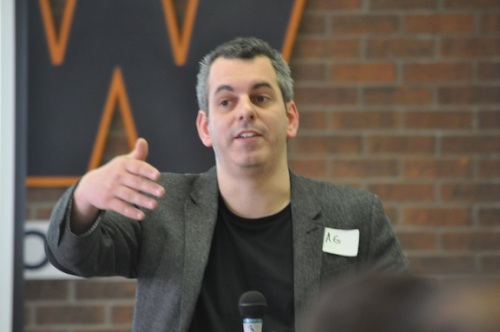Dr. Marc Andre Gagnon says that while Medicare is sustainable, rising drug costs are not.
A leading expert on pharmaceutical policy in Canada, Carleton University’s Gagnon spoke Saturday at the Students for Medicare conference in Toronto.
Gagnon says drug costs have been rising by an average of 10 per cent annually since 1988. Even with the so-called “patent cliff” where major blockbuster drugs have dropped in price due to the recent availability of generics, overall drug costs are still rising by 4.7 per cent per year.
The patent cliff benefit won’t last according to Gagnon. Within two or three years costs will be rising again unless the system is reformed.
For Gagnon, it’s not so much a question of if we have reform, but what kind of reform we want. Drug costs in Canada and Japan are rising faster than any other industrialized nation and provinces are under pressure to act.
In Canada 44 per cent of spending on drugs is public, 38 per cent paid for by private insurance, and 18 per cent paid out-of-pocket.
While Canadians have paid high prices for their drugs, the promise that these prices would reflect higher private sector investment in research and development has not been met. In return for lengthy patent protection, drug companies in Canada committed to investing 10 per cent in R&D, but currently spend about 5.6 per cent. Other high-price countries, such as Switzerland, have much higher levels of private research funding.
Of the $960 million spent by pharmaceutical companies on research in Canada, about half ($461 million) of that cost is offset by tax credits.
Reform is unlikely to come from the private sector. Insurance companies have no incentive to reduce costs and are themselves under pressure by employers when it comes to managing the drug formulary. Gagnon says union members often demand brand name coverage even when there is no difference in outcome with lesser-priced generics. 95 per cent of private drug plans have no mandatory generic substitution in Canada. Further three out of four private insurance drug plans have no caps on dispensing fees.
Gagnon estimates the cost of “waste” in the system – higher priced prescriptions that do not improve health outcomes – is estimated to be $5.3 billion (2011) – or 56 per cent of what we spend on prescription drugs.
Part of our problem is how we price drugs. Canada sets a cap on drug pricing based on the median cost of seven comparator countries. Four of the seven are among the most expensive in the world. Canada therefore usually ranks 4th or 5th most expensive.
Further, drug companies use confidential product listing agreements to play jurisdictions off against each other.
This is how it works: An expensive new drug comes on the market, but provincial drug plans are reluctant to place it on their formulary given the cost and low net health benefit over existing lower-priced drugs. A drug company uses a larger player – such as Ontario – to add it to their formulary by enticing them with very significant cost rebates. Pressure builds in other jurisdictions – some from patient advocate groups funded by the drug companies – to have access to the same drug as Ontarians. Under intense political pressure, other provinces follow suit but do not know what Ontario paid, and end up negotiating much smaller discounts. Once it has been accepted by the provinces, the private insurance companies pay the full retail price.
Two-thirds of new patent drugs have no added therapeutic value according to Gagnon.
While Gagnon argues that it’s time for a national drug plan that will give everyone access to the pharmaceuticals they need, it will not be “open bar” for everyone.
He says there is a need for “institutional capacity” for more rational prescribing.
While Canada would save a minimum of 10 per cent on drug expenditures through a national Pharmacare program, moving to more aggressive plan – such as the one used in New Zealand – could lead to savings more on the magnitude of 42 per cent.
While costs have escalated dramatically in Canada, pharmaceutical costs have remained flat in New Zealand.
How is it that a country of 4.4 million people can better negotiate drug pricing that Canada with a population of close to 34 million?
Given drugs are Canada’s second biggest health care cost after hospitals, politicians would do well to pay attention.
Dr. Marc Andre Gagnon will be speaking in Ottawa at the Canadian Health Coalition Pharmacare 2013 conference May 24-25th . For those interested in attending, please click here. To read Gagnon’s Canadian Centre for Policy Alternatives paper, The Economic Case for Universal Pharmacare, click here.




This was an issue recognized a LONG time ago by the Royal Commission on the Future of Canadian Health Care.
This Commission identified that the three main runaway expenses were:
1. Pharmaceutical costs
2. Medical hardware and machinery
3. Senior administrative costs
Organized labour costs and other incidental labour costs such as temporary nursing staff were identified as nearly negligible.
None of these costs were in check with inflation (nor have they been since 2002) and all should be severely reduced before they crush Canada’s health care system.
We need to appreciate that we could be one of the world’s largest buyers of these services and when we hold the budget dollars, we have the negotiating power.
Pingback: Health Council of Canada is Gone: But why? | The Benefits Blog